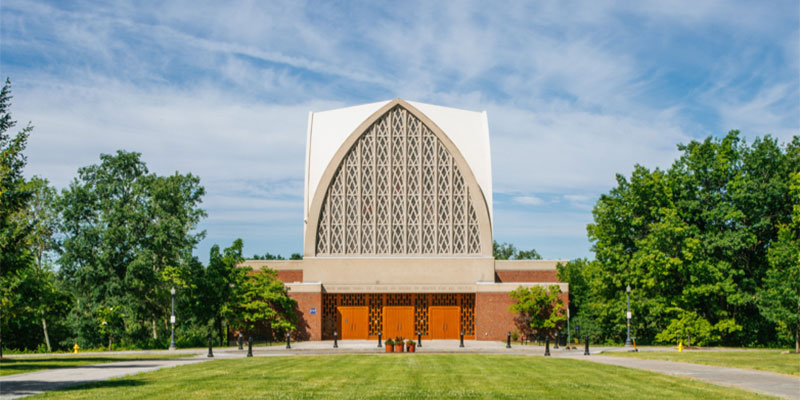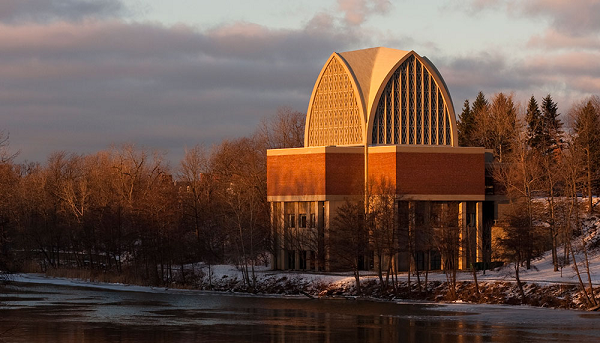
| River Campus | Interfaith Chapel |
 |
| Interfaith Chapel |
 |
| Interfaith
Chapel from the Genesee River |
Mandatory chapel services were held at the University until 1927, when they became optional. After the move to River Campus, services were held in Todd Union and Strong Auditorium.
In 1967 ground was broken for an Interfaith Chapel on the east wide of the river on the opposite end of the Eastman Quadrangle from Rush Rhees Library. The building was made possible by a gift from Mr. and Mrs. Gilbert J.C. McCurdy, of the McCurdy Department Store.
References
1967 "River-Edge
Site Selected for U. of R. Chapel," Democrat and Chronicle,
September 24, 1967, Page M1.
A gift from Mr. and Mrs. Gilbert J.C. McCurdy made the building
possible. He was president of the McCurdy Department store from 1931
to 1962.
1967 "Chapel Construction To Begin On Genessee Bank This Fall," Campus Times, September 26, 1967, Page 1 | Part 2 |
1967 "Start
Slated on UR Chapel," Democrat and Chronicle, October 15,
Page M1.
Groundbreaking ceremonies at 3 p.m. today.
1970 "Dedication Service to Mark Interfaith Chapel Opening," Campus Times, May 19, 1970, Page 3.
1971 "Gilbert J.C. McCurdy," University of Rochester Living History Project
1977 History
of the University of Rochester, 1850-1962, by Arthur J.
May. Expanded edition with notes
Chapter 24, Beyond the Curriculum
Oscillations in University policy on formal religious exercises advertised
the point that the authorities were groping for something worthy and
worthwhile in a period of increasing secularism. Campus editorials more
than once pilloried compulsory chapel as a meaningless gathering, and when
meetings were renamed assemblies not much difference was detected by the
students.
Faculty legislation of 1927 prescribed secular assemblies, some of them
compulsory, and voluntary religious services each week with sermonettes
and music, men and women attending. Meetings were held either in Catharine
Strong Hall or the Art Gallery Theatre. In the opinion of President Rhees
this revolutionary departure from the long-standing tradition of
obligatory chapel attendance "Tended to advance the spiritual life of the
college," and he very much hoped that a structure for religious devotions
would be erected on the River Campus. Yet whatever the name, student
response to non-obligatory corporate meetings was decidedly limited.
Annually on Armistice Day, classes were suspended so that the college
community might meet for commemorative rights.
Chapter 38, Undergraduate Life Beside the Genesee
What eventually was called the University Protestant Chapel, begun by
enterprising V- 12ers in the summer of 1946, held worship services on
Sunday morning in Strong Auditorium; buses furnished transportation for
Prince Street and Eastman School students. So that veterans with families
might attend, a child care service was introduced, soon supplemented by a
Sunday School; after the morning worship coffee was served during a
"fellowship hour," and once a year the service was held out of doors and
followed by a picnic. Policy decisions were made by a cabinet, meeting
monthly and composed of twelve undergraduates, two faculty advisers, the
chaplain and his assistant (as a rule, a Colgate-Rochester student);
weekly bulletins on the plans of the chapel were published. Strong pleas,
without immediate effect, were addressed to the trustees to build a chapel
for religious devotions; wrongly, it was imagined that George Eastman had
opposed a place of worship when the River Campus was being constructed.
A Christian Science organization was founded (1949) to serve the interests
of students of that faith; a student leader conducted biweekly testimonial
meetings, and a lending library and a lecture program were sponsored.
"Bible literalists," an evangelical group calling themselves the
Inter-Varsity Christian Fellowship, eagerly sought to win converts; one
adherent tacked a scriptural verse to the door of his dormitory room,
which inspired a rash of parodies on other doors.
The well-established Newman Club, much bigger than before the war,
functioned as "the Catholic Church on the Campus.'' A Jewish Cultural
Group, formed in 1947 to cultivate the values of that faith, grew (1948)
into a unit of the Hillel Foundation, which had branches in over 180
colleges; Supported in part by the B'nai B'rith organization, Hillel aimed
to strengthen the religious and cultural heritage of Judaism and to assist
students in adjusting to the college environment. Subject to approval by
the University officers, a young rabbi served as counselor to Hillel,
which drew members not only from the University, but also from the
Rochester Institute of Technology and the Rochester Business Institute.
A loose Interfaith Council was created, which each year sponsored a campus
conference on religion. A faculty "consultation on religion" was conducted
(1947) by Willard L. Sperry, dean of the Harvard Divinity School, and in
cooperation with Colgate-Rochester and the Jewish Theological Seminary,
students from both campuses participated in a conference at Cutler on
"Modern Man and Moral Maturity" (1951).
Shortly upon assuming the presidency, de Kiewiet took a firm hand in River
Campus religious life. In the first place, he lined up what had long been
wanting, outside non-denominational financial support, a $15,000 annual
grant from the Pew Memorial Foundation. Secondly, he appointed a committee
of three faculty and administrators, one from each major faith, to study
student religious needs. The committee recommended (1953) that the
University sponsor a multi- and interfaith program, providing worship,
counseling, opportunities for social work, and social activities. A full
time chaplain, responsible to the University rather than to. any
particular denomination, should be appointed. Though course offerings in
religion should be extended, the chaplain should teach only to an extent
not detrimental to his principal functions, religious and spiritual
counseling and university-wide coordination of all student religious
activities. Again, need for an interfaith chapel was put forward, or at
the very least a religious activities building. (Ground for an interfaith
chapel was broken in 1967, the gift of the McCurdy family of Rochester.)
© 2021 Morris A. Pierce